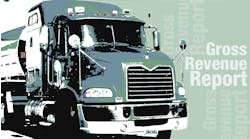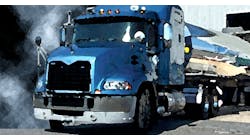Latest from Gross Revenue Reports
TANK TRUCK carriers weathered another tough year in 2003. The Modern Bulk Transporter Annual Gross Revenue Report showed continued erosion of operating ratios, something that has been underway for much of the past five years.
Almost three-quarters of the fleets participating in the Annual Gross Revenue Report recorded 2003 operating ratios that were worse than the previous year. More than half of the fleets achieved higher revenues in 2003, slightly better than in the previous year's Gross Revenue Report.
Tank truck carriers struggled even as the general economy began a long-awaited recovery from recession. Chemical haulers were hurt by a 15% to 20% drop in shipments, and dry bulk transporters saw a decline of 20% to 40% in plastic pellet loads.
Carrier overcapacity, combined with the drop in shipments, brought intense downward pressure on rates. Shippers increasingly turned to Internet auctions and other electronic pricing schemes to hammer rate structures.
Rate cutting wasn't the only problem, though. A recovering economy brought a 4.1% increase in demand for diesel and other distillate products, which, in turn, resulted in higher fuel costs for truck fleets. Lower-emission diesel engines helped boost the price of new trucks. Concerns about terrorism have prompted requirements for higher levels of security, all of which have raised operating costs for tank truck fleets.
Not surprisingly, the drop in profitability and increase in operating costs were more than some tank truck carriers could stand. Of the 5,000 or so trucking companies that shut down in 2003, as many as 200 of them may have been tank truck fleets, according to industry estimates.
The difficult tank truck economy also prompted a fresh surge of mergers and acquisitions during 2003. A significant number of small- and medium-sized tank fleets sold out, industry experts say, and more would have if they could have found buyers.
Among the mergers and acquisitions in 2003: Kenan Advantage Group added to its stable of petroleum fleets with the purchase of Beneto Tank Lines of Sacramento, California. Quality Carriers added at least two affiliates — Erickson Transport Corp and Eaton's Trucking Service — as well as purchasing the liquid tank business from a large dry bulk fleet.
Even with the mergers and acquisitions, the largest tank truck carriers struggled as much as the rest of the industry. Only half of those participating in the Modern Bulk Transporter Annual Gross Revenue Report achieved higher revenues and improved their operating ratios.
Among the Top 10, Quality Distribution Inc headed the list once again. Trimac Transportation Services Inc and The Kenan Advantage Group were two and three respectively. Rounding out the Top 10 were Superior Bulk Logistics Inc, Groendyke Transport Inc, Schneider National Bulk Carriers Inc, Bulkmatic Transport Company, Enterprise Transportation Company, A&R Transport Inc, and Tankstar USA (new to the Top 10).
The combined Top 10 revenues of $2.4 billion were slightly above 2002 and accounted for 49.6% of total revenues in the 2003 report. The Top 10 carriers accounted for 43% of the total in 2002.
The Top 25 carriers had $3.5 billion in revenues, or 73.8% of the total represented in this report. That was a significant jump over the Top 25 total in 2002, which accounted for 65.2% of that report. The 50 largest carriers had revenues of $4.5 billion, accounting for 93.3% of the total, compared with 82.5% in 2002.
Of the 94 carriers in this report, almost two-thirds recorded higher revenues in 2003 than in 2002. Only about a third showed improved operating ratios.
Total 2003 revenues for all 94 carriers in this report were $4,834,777,091. In contrast, the 2002 report consisted of 135 carriers reporting a combined total of $5,052,471,196.
Average revenue in 2003 for these 94 carriers was $51,377,479, up considerably from the average of $37,425,712 for 135 fleets in 2002. The median carrier on the list, the one with an equal number of carriers above and below it, had revenues of $21,263,577. In 2002, the median carrier revenue was $15,298,975.
Operating ratios for both 2003 and 2002 were supplied by 78 of the carriers in this report. Just 29 showed improvement over the previous year. The operating ratio represents operating expenses as a percentage of revenue.
Still, many of the tank truck carriers were able to limit the damage to their operating ratios. There was no major surge in operating ratios above 95%. Fifty-five fleets had operating ratios between 95.0% and 99.9%, compared with 58 in 2002. Three carriers recorded ratios of 100% or higher, down from five. Ratios between 90.0% and 94.9% were reported by 21 companies, up from 14 in 2002. However, only one carrier had a ratio below 90%.
A majority of carriers in the report supplied tractor revenues, which give an indication of productivity levels. The average for 2003 was $151,820, down slightly from the $154,966 average in 2002.
Eight of the Top 10 reported tractor revenues, and their average was $160,955. That was a clear improvement over the $152,408 average reported by the Top 10 in 2002.
For the second year, an East Coast petroleum hauler recorded the highest revenue per tractor, $296,771. The lowest amount ($66,444) came from a West Coast food fleet.
Average revenue per tractor for 10 petroleum transporters was $176,887, down from the previous year's average of $219,486, but still well above the average for all carriers in this report. Petroleum tractor revenues ranged from the overall high of $296,771 to a low of $100,447.
Nine chemical haulers accounted for average revenue per tractor of $163,091, above the average for all of the carriers in the report. The average for chemical fleets in 2002 was $149,434. Tractor revenues ranged from a high of $203,884 down to $105,200.
Average tractor revenue for five dry bulk specialists was $162,973, down from the $189,044 average recorded in 2002. Tractor revenues ranged from a high of $210,757 to a low of $106,830.
Among four carriers specializing in transporting liquid and dry foods, average tractor revenue was $124,489. That was slightly above the $120,413 tractor revenue average in 2002. The high for the category was $175,656, and the low was $66,444.
Many of the figures here are from preaudited reports, and some may include nonbulk revenues or revenues from subsidiary tank truck carriers. In most cases, the figures were supplied directly to Modern Bulk Transporter. The editorial staff greatly appreciates the cooperation of all who helped in the preparation of this report.
To view a chart with this year's ranking and revenues, use the "Related" link below to find it and all reports going back to 2001 in the Gross Revenue Reports Archive.









